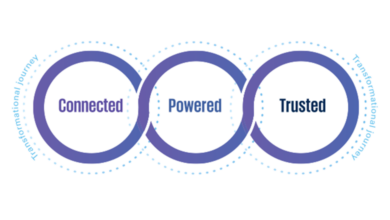Driving Digital Transformation
Pat Millar, Managing Director, Clarion Consulting Limited, outlines how he sees ‘digital’ impacting on organisations across a number of sectors and provides the first steps in preparing a roadmap for digital transformation.
Digital transformation
Digital transformation is having a significant impact on organisations across many sectors. While it is easy to think that the changes being driven by Digital are more relevant to other sectors, I believe that this is a mistake. Not everyone will be impacted to the same degree or at the same pace, but digital transformation represents a very significant change in the way we work and live.
As with all technological advances, separating the hype from the reality is a challenge but organisations that ignore the impact of digital are taking a significant risk. While the impact of digital is felt in many ways, I would like to focus here on just a few key areas and give readers some things to consider as they decide what digital transformation means to their organisation.
Customer engagement
Social channels have a big impact on how people collaborate and how relationships are built and maintained. Social channels offer the ability to interact with customers and employees in much more meaningful ways and create more opportunities to hear the voice of the customer. Social media also allows customers to engage with your brand in new ways. Mobile computing makes it possible for people to be available and productive no matter where they are.
The ability to get closer to the customer allows us to deliver a more personalised experience to customers and to gain valuable insights into what they feel about our products and services. Attracting and retaining customers is a key objective of any commercial business and making it easier to do business with your organisation should be an objective for any organisation regardless of sector.
We also need to bear in mind that the expectation of customers is rising significantly and the voice of the customer is more visible to a broad audience. Bad customer experiences are likely to be shared widely. Today this is done at the click of a mouse.
Technology adoption
The ability to adopt new technologies is an area that you need to consider carefully when defining a digital strategy for your organisation. You need to understand your existing capabilities and take an honest look at whether these are fit for purpose in a digital world.
Traditionally, large organisations invested heavily to develop capabilities to complete large-scale rollouts of new technologies using structured systems development and project management methodologies. These approaches involved strong governance and clear lifecycles with an emphasis on reducing risk. Systems development was the responsibility of the IT function who were seen as the experts in technology. These type of rollouts take many months to complete and are carefully planned and executed. They also consume very significant amounts of IT and business resources.
Today organisations are demanding quicker adaption of new technologies and looking for incremental improvements rather than large-scale rollouts. Businesses are trimming application portfolios to free up more staff to work on strategic projects. Agility is key here and IT functions cannot afford to be seen as not meeting business needs/blocking progress due to standards, security, processes or governance. This is a significant challenge for CIOs. A September 2014 Harvard Business School survey found that only 11 per cent of organisations viewed the level of responsiveness of their IT functions when it comes to providing new and innovative enterprise software applications/solution as very responsive.
The challenge for CIOs is that they have spent many years building capability to implement and manage large applications and complex IT networks in a secure way. Many of the governance processes and methodologies that have served IT functions so well are simply not fit for purpose in today’s environment. Organisations need to increase their level of agility and build the capability to support the rapid deployment of applications. If IT functions cannot do this then their organisations will look elsewhere.
A further consideration for organisations is deciding who plays what application development role in the organisation. Traditionally IT functions had clear ownership of developing applications but this distinction has become blurred and business functions in many organisations are developing their own apps to support their business needs.
Much closer partnerships between the business and IT in the development process are required. IT and business teams need to work more closely together on an ongoing basis. IT functions need to both support business applications and enable the business to play a more active role in the development of front-end apps i.e. they need to open up the systems, tools, and processes to allow business users to drive these initiatives forward themselves.
Interestingly both Gartner & Boston Consulting Group recommend a “two speed IT” where one part of the IT function is focused on maintaining a steady core IT while another works to develop an agile capability. The above require different skills and capabilities and a different orientation with digital requiring agile methodologies, and iterative short cycle times for technology adoption.
Talent
Accessing the talent we require in a digital world is challenging and that challenge is growing as more organisations chase the same limited number of skilled resources. A Gartner annual CIO Agenda report for 2014 concluded that 5 per cent of CIOs are concerned digital is happening faster than they can cope with and 42 per cent believe that they do not have the right skills and capabilities to handle the changes. Employees are more in demand and increasingly mobile. They are also moving jobs more frequently.
The skills required here are not just technical skills. Digital demands greater customer facing skills, marketing skills and the ability to drive organisational change. Accessing the right talent is becoming more challenging all the time and organisations need to look at how they can collaborate with customers, suppliers and Universities to access the skills they need.
Getting started
So where should you start and how do you know what your organisation needs to do to map out a roadmap for digital transformation. As with all change initiatives, you need to understand where you want to go (you need a clear vision) and where you are now before you decide how you get there. Some good initial questions to ask include:
• How well do we as an organisation understand the digital challenge and what it might mean for our organisation?
• What will the benefits for us be?
• What are our strengths and weaknesses as an organisation?
• What are others in our sector doing and how do we compare with them?
• What are our customers looking for and how do we know?
• What is the appetite for change and how good is our organisation at driving change?
• Who will lead the transformation (who is the best person to do this?)
• How will we mobilise our organisation for this?
• How can we encourage a shift to digital at all levels?
• What skills and what help will we need?
• How will we pay for this?
• Where might be a good starting point for us (are there any quick wins)?
• Are we prepared to fail?
At Clarion we have considerable experience as a Change Partner helping both private and public organisations answer these questions and more. While it is critical for success knowing where you are starting from and where you want to go; it is equally important to have a trusted partner helping you on the journey.
Pat Millar
Managing Director
Clarion Consulting Limited
pmillar@clarionconsulting.com
www.clarionconsulting.com







